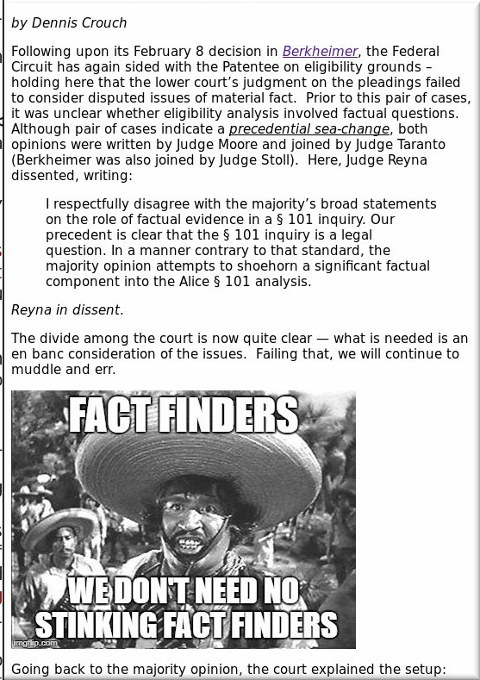

SOFTWARE patents continue their rapid demise in the United States.
"Unified Patents has also just noted that its PTAB petition was likely successful and the "Walker Innovation" [sic] patent likely invalidated."One can imagine that the court/trial fees (attorneys etc.) were a lot higher than the cost of PTAB petitions (IPRs).
Unified Patent has also just noted that its PTAB petition was likely successful and the "Walker Innovation" [sic] patent likely invalidated. To quote:
On February 23, 2018, Unified filed a petition for inter partes review (IPR) against U.S. Patent 8,549,310 owned and asserted by Certified Measurement, a subsidiary of Walker Innovation and well-known NPE. The '310 patent, directed to a "method and apparatus for secure measurement certification," has been asserted in multiple cases against such companies as Yokogawa America, ABB, and Alstom.
"The patent micrososm is just trying to cause a controversy and allege that PTAB does not assess evidence/facts."We don't expect the patent micrososm to quit trying all sorts of tricks. Patently-O has already attempted to slow down PTAB and CAFC. Patently-O's Dennis Crouch was even asking his students to write essays which suit his agenda some years back (which raises ethical questions about his employer) and days ago he returned to student essays, this time from Lauren Kimmel about "Science Fiction Law". It wasn't long ago when we saw high school students exploited by Watchtroll for anti-PTAB propaganda, shrewdly constructed in a "think about the children!" fashion.
Another site of the patent micrososm wrote a PTAB rant last week. Andrew Williams said:
Last year, the Federal Circuit decided the Aqua Products, Inc. v. Matal case en banc in what could be considered the epitome of a fractured decision. After 148 pages and five separate opinions, the only agreed-to result could be summed up in two conclusions: (1) that the PTO had not adopted a rule regarding the burden of persuasion, and that (2) because there was nothing that was entitled to deference, "the PTO may not place that burden on the patentee." Nevertheless, Judge Rayne's concurrence-in-part, at Part III, articulated a rule regarding the burden of production, even if there was disagreement whether it was a judgement of the Court or mere "cogitations." This conclusion was that, in the absence of a properly promulgated rule, "the Patent Office must by default abide by the existing language of inter partes review statute and regulations, ۤ 316(d) and 37 C.F.R. ۤ 42.121, which only allocate a burden of production to the patent owner." At the time, we did not know whether the Board would follow Judge Rayne's pronouncement. But in the interim, the picture has become clear.